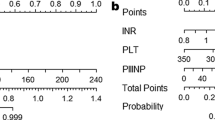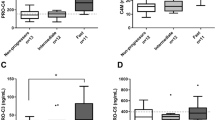Summary
Objective
The objective of the study was to improve the accuracy of survival prognosis in patients with liver cirrhosis using procollagen III peptide (PIIIP), as a marker of inflammation and fibrogenesis, and Knodell’s histologic activity index (KI) in addition to previously used prognostic factors.
Patients and methods
Five-year survival was followed in a group of 75 patients with hepatitis B virus (HBV) liver cirrhosis (patients testing anti-HBe positive and HBV-DNA negative). There were 31 patients with compensated cirrhosis and 44 with decompensated cirrhosis. The diagnostic procedure included clinical laboratory, ultrasound and pathohistologic examination. We combined PIIIP and KI with other significant variables to achieve the highest possible sensitivity, specificity and accuracy for survival prognosis in HBV liver cirrhosis. The models were compared using ROC analysis.
Results
At the end of the five-year period of survival follow-up, there were 39 survivors and 36 patients had died (only three died from an extrahepatic cause). In the quantitative model, the discriminant canonical function (DCF) identified PIIP, bilirubin, prothrombin time, ascites and KI as statistically significant parameters in the prognosis of five-year survival. Calculation of the score based on DCF yielded an accuracy of 89.3%. In the semiquantitative model, the analysis of variance identified PIIIP, bilirubin, albumin, pro-thrombin time, alkaline phosphatase, ascites and KI as significant variables. When PIIIP was added to the clinicohistologic diagnosis, Child-Pugh score and KI, the level of accuracy improved by 12% (from 78% to 90%), 11% (from 79% to 90%) and 10.6% (from 80% to 90.6%), respectively. When calculated with the three biochemical parameters (alkaline phosphatase, PIIIP and bilirubin) and KI identified by DCF, the accuracy was 90.6%.
Conclusion
Combining PIIIP and KI with other prognostic parameters is useful in achieving a better precision of survival prognosis in patients with HBV liver cirrhosis.
Similar content being viewed by others

References
Annoni G, Colombo M, Cantalupi CM, Khalt B, Lampetrico P, Rojklind M (1989) Serum type III procollagen peptide and laminin (Lam-PI) detect alcoholic hepatitis in chronic abusers. Hepatology 5: 693–697
Chang TT, Lin HC, Lee SD, Tsai YT, Lee FY, Jeng FS, Wu JC, Yeh PS, Lo KJ (1989) Clinical significance of serum type III procollagen amylopeptide in hepatitis B virus related diseases. Scand J Gastroenterol 24: 533–538
McCullough AJ, Stasen WN, Wiesner RH, Czaja AJ (1987) Serum type III procollagen peptide concentrations in severe chronic active hepatitis: relationship to cirrhosis and disease activity. Hepatology 7: 49–54.
Murawaki Y, Ikuta Y, Nishimura Y, Koda M, Kawasaki H (1996) Serum marker for fibrosis and plasma transforming growth factor beta 1 in patients with hepatocellular carcinoma in comparison with patients with liver cirrhosis. J Gastroenterol Hepatol 11: 443–450
Realdi G, Fatovich G, Hadziyannis S, Hadzyannis S, Schalm SW, Almasio P, et al (1994) Survival and prognostic factors in 366 patients with compensated cirrhosis type B: multicenter study. The investigators of the European Concerted Action on Viral Hepatitis (EUROHEP). J Hepatol 21: 656–666
Teare JP, Sherman D, Greenfeld SM, Simpson J, Bray G, Cattarall AP, et al (1993) Comparison of serum procollagen III peptide concentrations and PGA index for assessment of hepatic fibrosis. Lancet 342: 859–868
Trinchet JC, Hartmann DJ, Pateron D, Laarif M, Callard P, Ville G, et al (1991) Serum type I collagen and N-terminal peptide of type III procollagen in chronic hepatitis. Relationshiop to liver histology and conventional liver tests. J Hepatol 2: 139–144
Camps J, Crisostomo S, Granero GM, Gracia-Granero M, Riezu-Boj JI, Civeira MP (1993) Prediction of the response of chronic hepatitis C to interferon alfa: a statistical analysis of pretreatment variables. Gut 34: 1714–1717
Sarin SK, Sundaram KR, Ahuja RK, Anand BS, Broor SL (1988) Youngvs. adult cirrhotics: a prospective, comparative analysis of the clinical profile, natural course and survival. Gut 1: 101–107
Sherlock S (1997) Diseases of the liver and biliary system, 10th edn. In: Sherlock S (ed) Blackwell, Oxford London Edinburgh Boston Melbourne
Knodell RG, Ishak KG, Black WC, Chen TS, Craig R, Kaplowitz N (1981) Formulation and application of a numerical scoring system for assessing histological activity in asymptomatic chronic active hepatitis. Hepatology 1: 431–435
Jongh FE, Jansen HL, de Man RA (1992) Survival and prognostic indicators in hepatitis B surface antigen-positive cirrhosis of the liver. Gastroenterology 103: 1630–1635
Christiansen E, Schiliching P, Fauerholdt L (1984) Prognostic value of Child-Turcotte criteria in medically treated cirrhosis. Hepatology 3: 430–435
Christiansen E, Shcilding P, Andersen KP, Fauerholdt L, Schou G, Pedersen VB, Juhl E, Poulsen H, Tygstrup N, Copenhagen Study Group for Liver Diseases (1986) Copenhagen Study Group for Liver Disease. Updating prognosis and therapeutic effects evaluation in cirrhosis with Cox’s multiple regression model for time-dependent variable. Scand J Gastroenterol 21: 163–174
Orego H, Israeli Y, Blake JE, Medline A (1983) Assessment of prognostic factors in alcoholic liver disease: toward a global quantitative expression of severity. Hepatology 6: 896–905
Behringwerke AG (1991) RIA-gnost Procollagen-III-peptide Kit for the radioimmunoassay of the procollagen III peptide. Instructions for use. Prod. No. ODMT. Behring-werke AG Diagnostica, Marburg, pp 1–27
Hayes P, Gimson, David W (1988) Aids to gastroenterology and hepatology. Churchill Livingstone, Edinburgh London Melbourne New York, pp 155–158
Niemela O, Risteli J, Blake JE, Risteli L, Compton KV, Orego (1990) Markers of fibrogenesis and basement membrane formation in alcoholic liver disease. Relation to severity, presence of hepatitis and alcohol intake. Gastroenterology 98: 1612–1619
Yamada M, Fukuda Y, Koyama Y, Nakano I, Urano F, Katano Y, Hayakawa T, et al (1996) Serum hyaluronic acid reflects the effect of interferon treatment on hepatic fibrosis in patients with chronic hepatitis C. J Gastroenterol Hepatol 11: 646–651
Neveau S, Poynard T, Abela A, Pignon JP, Poitriane A, Agostini H, Zourabichvili O, Chaput JC (1985) Prognostic value of serum fibronnectin concentrations in alcoholic cirrhotic patients. Hepatology 5: 819–823
Bayerdörffer E, Lamerz R, Fliege R, Köpcke W, Mannes G (1991) Predictive value of serum procollagen III peptide for the survival of patients with cirrhosis. J Hepatol 13: 298–304
Ikeda K, Kumada H (1994) Long-term prognosis of liver cirrhosis. Nippon Rinsho 51: 63–68
Chu CM (2000) Natural history of chronic hepatitis B virus infection in adults with emphasis on the occurence of cirrhosis and hepatocelullar carcinoma. J Gastroenterol Hepatol 15 [Suppl]: E25–30
Franklin MK, Thomas L, Fabry MP, Schafner F (1992) Prediction of survival of patients with primary biliary cirrhosis. Examination of the Mayo Clinic model of a group of patients with known endpoint. Gastroenterology 102: 310–313
Schneider JF, Baker AL, Haines NW, Baker A, Haines NW, Hatfield G, et al (1980) Aminopyrine N-determination: a prognostic test of liver function in patients with alcoholic liver disease. Gastroenterology 79: 1145–1150
Siciliano M, Milani A, Marra L, Rossi L (1987) Serum bile acids in liver cirrhosis: prognostic significance evidenced by multivariate statistics model. Gastroenterology 5: 721–725
Fattovich G, Giustina G, Schalm SW, Hadziannis S, Sanchez-Tapias J, Almasio P (1995) Occurrence of hepatocellular carcinoma and decompensation in western European patients with cirrhosis type B. The EUROHEP Study Group on Hepatitis B Virus and Cirrhosis. Hepatology 21: 77–82
Balanzo J, Such J, Sainz S (1990) Long term survival and severe rebleeding after variceal sclerotherapy. Surg Gynecol Obstet 6: 489–492.
Casttera I, Hartmann DJ, Chapel C, Guettier C, Mall F, Lons T (2000) Serum laminin and type IV collagen are accurate markers of histologically severe alcoholic hepatitis in patients with cirrhosis. J Hepatol 32: 412–418
Zuner CA, Apsner RC, Kranz A, Kramer L, Madl C, Schneider B (1996) Outcome prediction for patients with cirrhosis of the liver in a mdeical ICU: a comparison of the APACHE scores and liver specific scoring systems. Intensive Care Med 1996 22: 559–563
Babbs C, Hunt L, Haboubi N, Smith A, Rowan BP, Warens TW (1988) Type III procollagen peptide: a marker of disease activity and prognosis in primary biliary cirrhosis. Lancet i: 1021–1024
Jansen P (1990) Life expectancy in liver cirrhosis after the first variceal hemorhage: whose survival can be improved. Scand J Gastroenterol 178P [Suppl]: 196–210
Rivard CI, Esnaola S, Villeneuve JP (1987) Clinical and statistical validity of conventional prognostic factors in predicting short-term survival among cirrhotics. Hepatology 7: 660–664
Author information
Authors and Affiliations
Corresponding author
Rights and permissions
About this article
Cite this article
Babić, Ž., Bilić, A., Babić, D. et al. Predictive role of serum procollagen III peptide and Knodell’s index in survival prognosis of patients with hepatitis B virus liver cirrhosis. Wien Klin Wochenschr 115, 302–308 (2003). https://doi.org/10.1007/BF03040336
Received:
Accepted:
Issue Date:
DOI: https://doi.org/10.1007/BF03040336



